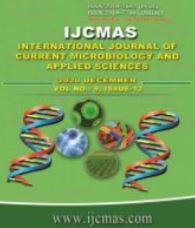


 National Academy of Agricultural Sciences (NAAS)
National Academy of Agricultural Sciences (NAAS)

|
PRINT ISSN : 2319-7692
Online ISSN : 2319-7706 Issues : 12 per year Publisher : Excellent Publishers Email : editorijcmas@gmail.com / submit@ijcmas.com Editor-in-chief: Dr.M.Prakash Index Copernicus ICV 2018: 95.39 NAAS RATING 2020: 5.38 |
A field experiment entitled “Physiological investigations on response of post emergence application of weedicides in maize [Zea mays (L.)]” was conducted at Research Farm, AICRP on Forage Crops, Department of Agronomy, JNKVV, Jabalpur (Madhya Pradesh) during Kharif season of the year 2018-19. The treatments comprised of 7 weeds control methods viz. application of mesotrione 40%SC@250mlha-1, mesotrione 40%SC @ 300mlha-1, mesotrione 40% SC @ 350mlha-1, paraquat dichloride 24% SL @ 2000ml ha-1, tembotrione 34.3% SC @ 286ml ha-1, one plot was kept weeds free and another kept untreated in each replication. The research experiment was laid out in a randomized block design replicated thrice. Treatment T6 (Hand weeding) possessed an average higher value for dry matter production at initial (1.861g) and at maturity (347.16g), an average higher LAI (3.25), LAD (66292.62 cm2.days) and CGR (0.008879gcm-2day-1). Higher magnitudes of physiological traits in T6 (Hand weeding) had reflected to its highest grain yield (2812.423kgha-1). Treatment T5 (tembotrione 34.3% SC @ 286mlha-1) was adjudged second in yield performance (2623.45kgha-1). The treatment T7 (control) recorded the minimum seed yield (1036.53 kgha-1). In proximate analysis treatment T6 (Hand weeding) registered maximum protein (9.87%) and fat (4.00%) contents. T3 (Mesotrione 40%SC@350mlha-1) noted maximum amount of carbohydrate (70.46%) and fiber (2.73%), whereas T6 (Hand weeding) had highest value of ash content (2.67%).
 |
 |
 |
 |
 |